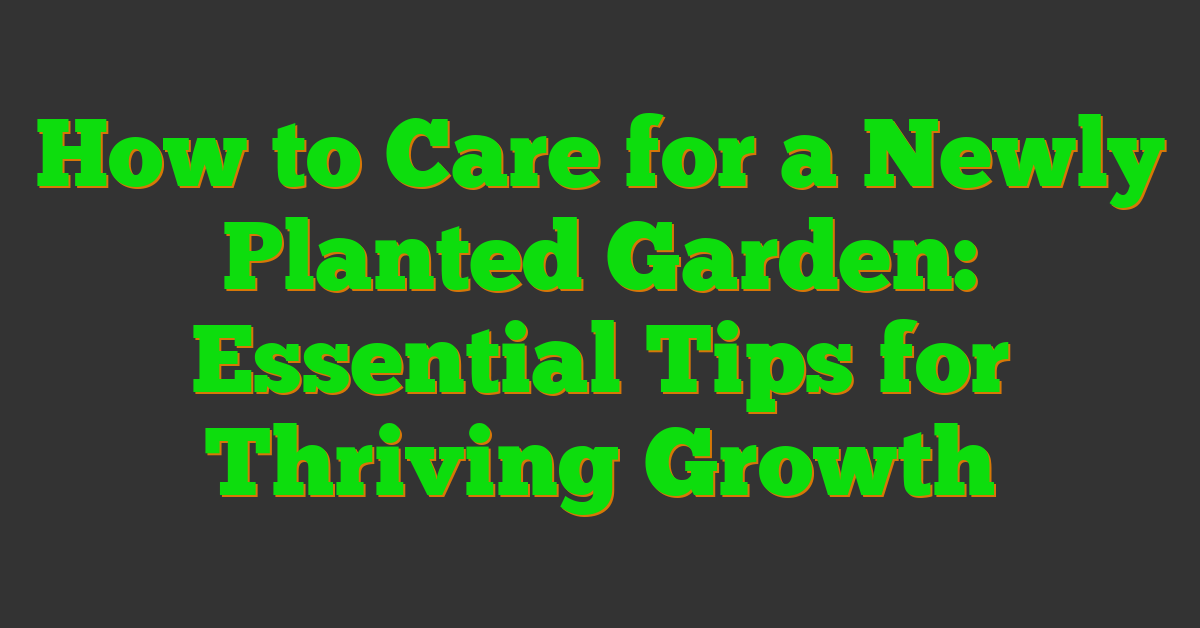Starting a new garden is always exciting. I remember the thrill of planting my first seeds and imagining the vibrant colors and lush growth to come. But nurturing a newly planted garden takes more than just enthusiasm.

From proper watering techniques to ensuring the right amount of sunlight, there are several key steps to help your garden thrive. Let me guide you through the essentials to keep your new plants healthy and flourishing.
Selecting the Right Plants
- Climate: Choosing plants adapted to my region’s climate, such as drought-tolerant succulents in arid areas, enhances their survival and growth.
- Soil Type: Matching plants with my soil’s composition, like moisture-loving ferns in clay soil, improves their health and productivity.
- Sunlight Requirements: Ensuring plants receive the appropriate amount of sunlight prevents stress and promotes blooming. For example, sunflowers thrive in full sun.
- Water Needs: Selecting plants with compatible water demands aligns with my watering schedule, reducing maintenance. Cacti require less frequent watering compared to hydrangeas.
- Growth Habit: Understanding plants’ growth patterns helps in planning the garden layout and spacing. Climbing roses need support structures, while groundcovers spread horizontally.
Preparing the Soil
I ensure my garden starts strong by properly preparing the soil. This foundation supports healthy plant growth and maximizes productivity.
Soil Testing and Amendment
First, I test the soil’s pH and nutrient levels using a home testing kit or by sending a sample to a local extension office. Testing helps identify deficiencies and imbalances. Based on the results, I amend the soil:
- Adjust pH: I add lime to raise pH or sulfur to lower it, aiming for a pH between 6.0 and 7.0.
- Correct Nutrients: I incorporate specific amendments like bone meal for phosphorus or potassium sulfate for potassium deficiencies.
Adding Compost and Fertilizers
Next, I enrich the soil with compost and fertilizers to enhance fertility and structure. Compost improves soil texture, drainage, and microbial activity. I apply a 2-3 inch layer of compost and mix it into the top 6 inches of soil. For additional nutrients, I use balanced fertilizers, following the manufacturer’s instructions for application rates. This combination ensures my plants receive the essential nutrients they need to thrive.
| Amendment Type | Purpose | Application Rate |
|---|---|---|
| Lime | Raise soil pH | 5 lbs per 100 sq ft |
| Sulfur | Lower soil pH | 3 lbs per 100 sq ft |
| Bone Meal | Add phosphorus | 1 lb per 100 sq ft |
| Compost | Improve soil structure & fertility | 2-3 inches mixed in top 6 inches |
| Balanced Fertilizer | Provide essential nutrients | As per package instructions |
By carefully testing and amending the soil, I create an optimal environment for my newly planted garden to flourish.
Proper Watering Techniques
Effective watering keeps my new garden healthy and thriving. I focus on establishing a reliable watering schedule and choosing the right method for my plants.
Establishing a Watering Schedule
Consistency is key for new gardens. I:
- Monitor soil moisture daily using a moisture meter.
- Water deeply twice a week, providing 1 inch of water each session.
- Adjust frequency during hot or rainy periods to prevent overwatering.
- Mulch to retain soil moisture and reduce evaporation.
- Observe plant responses and modify the schedule as needed.
Drip Irrigation vs. Overhead Watering
Choosing the right watering method improves efficiency. I evaluate:
- Drip Irrigation
- Delivers water directly to plant roots.
- Reduces evaporation by up to 50%.
- Minimizes weed growth by keeping soil surface dry.
- Overhead Watering
- Covers large areas quickly.
- Suitable for lawns and ornamental plants.
- Can increase evaporation and promote fungal diseases.
I prefer drip irrigation for most garden plants due to its precision and water-saving benefits. However, I use overhead watering for areas where uniform coverage is necessary.
Mulching and Weed Control
Mulching and effective weed control are essential for maintaining a healthy garden. Implementing these practices ensures your plants thrive with minimal maintenance.
Benefits of Mulching
Mulching offers several advantages:
- Moisture Retention: It keeps soil damp, reducing the need for frequent watering.
- Temperature Regulation: Mulch maintains consistent soil temperatures, protecting roots from extreme heat or cold.
- Weed Suppression: It limits weed growth by blocking sunlight, decreasing competition for nutrients.
- Soil Improvement: Organic mulches break down, enriching the soil with essential nutrients.
Effective Weeding Strategies
- Manual Removal: Regularly pull weeds by hand to prevent them from seeding.
- Mulch Application: Apply a 2-3 inch layer of mulch to smother weed seedlings.
- Weed Barriers: Use landscape fabric under mulch to provide an additional layer of weed prevention.
- Proper Spacing: Planting densely reduces gaps where weeds can establish.
- Herbicide Use: If necessary, apply eco-friendly herbicides carefully to target weeds without harming your plants.
Protecting Your Garden
Keeping your garden safe from threats ensures healthy plant growth. Implement effective strategies to guard against pests and diseases.
Pest Management
I monitor plants weekly for signs of pests. Introducing natural predators like ladybugs controls aphids and mites. Using neem oil targets a variety of insects without harming beneficial species. Setting up physical barriers such as row covers prevents pests from reaching plants. I apply sticky traps near vulnerable areas to catch and reduce pest populations. Maintaining plant health through proper watering and nutrition makes plants less attractive to pests. When necessary, I use organic pesticides following label instructions to minimize environmental impact.
Disease Prevention
I prevent diseases by selecting disease-resistant plant varieties suited to my climate. Ensuring proper plant spacing improves air circulation, reducing fungal growth. I practice crop rotation to avoid soil-borne pathogens build-up. Cleaning tools and removing infected plant debris limits disease spread. Watering plants at the base prevents moisture on leaves, which can lead to mildew and blight. Applying mulch helps regulate soil temperature and moisture, creating less favorable conditions for disease development.
Conclusion
Starting a new garden has been an incredible journey for me. Watching each plant grow and thrive brings so much satisfaction and joy. It’s amazing how a little care and attention can transform a simple space into a vibrant oasis.
I’m excited to continue nurturing my garden and seeing it flourish throughout the seasons. Gardening has not only beautified my surroundings but also provided a peaceful escape from the everyday hustle. Here’s to many more green days ahead!
















